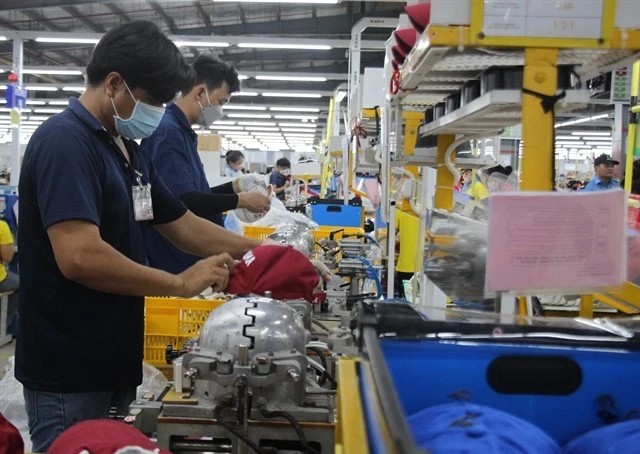Japan, Taiwan top places for labour export in 2019
 |
Taiwan and Japan are expected to remain the top destinations for Vietnamese workers this year with 90 per cent of all overseas employees working there.- Photo vov.vn
Nguyen Gia Liem, deputy director of the Department of Overseas Labour told a workshop on Vietnam’s labour export held in Quang Ninh province on October 4 that Japan in particular was the market of greatest potential for Vietnamese workers.
“Japan doesn’t only pay well but also is a market of cutting-edge science and technology with highly skilled labour,” Nghiem said.
Japan and Taiwan, however, were not the only markets receiving Vietnamese workers.
Deputy Minister of Labour, Invalids and Social Affairs Nguyen Thi Ha said up to one million workers have decided to work overseas under official contracts since 2006.
Labour export helped to alleviate the burden of creating jobs for the country’s young and dense population, she said, which provided employment for approximately 10 percent of the labour force.
While Vietnam continued sending most of its workers to its main labour markets in East Asia, Middle East and Malaysia, the Government is looking to expand its pool of receiving countries, the deputy minister said.
Brunei, Singapore and Saudi Arabia recently started taking in Vietnamese workers while other developed nations like Australia, the United States and Canada as well as European markets like Finland and Italy were also destinations workers were heading.
Market expansion was in line with an increase of occupations Vietnamese people are taking, Ha said, including many opting to work in the health sector as nurses and auxiliary staff.
The outlook for labour export may be bright, but the key challenge for Vietnamese workers to take advantage of such opportunity was their low skills, which greatly hindered them from higher incomes.
Professor Nguyen Canh Toan at Thang Long University said the rate of skilled labour barely reached 20 to 30 percent of the total overseas workers. Most of them, in fact, had manual jobs.
According to Toan, a Vietnamese worker’s monthly income minus living expense in markets of low pay like Malaysia ranged between 3 and 4 million VND (130-173 USD) or from 7 million to 12 million VND in middle-paying countries including those in the Middle East and Eastern Europe. The workers could earn up to 15 million to 20 million VND in top paying markets like Japan, the Republic of Korea and Taiwan.
While English is considered to be “the key to open treasures” when working overseas, it was one of the weakest skills of Vietnamese labour, Professor Toan said.
The average IELTS score of Vietnamese overseas workers stood at only 5.78, putting them in the low-middle group in terms of English proficiency, he said, lagging behind other ASEAN countries like Malaysia (6.64 points) and the Philippines (6.53 points).
Vietnam Labour Export Association Vice Chairman Nguyen Ngoc Quynh agreed that poor English was one of the biggest disadvantages of Vietnamese labour besides their disrespect to discipline.
“Many employers have said Vietnamese workers are hard-working but not following set rules and protocols,” Quynh said.
“Foreign companies now have to spend more time training our workers than those from other countries. But the training does bring out clear results, for example, workers in Japan after training have relatively good behaviour and quickly adapt to the new working environment.”
Professor Toan said the Government had to find a way to improve the quality of the workers for their own sake as countries who set high demands for skills and discipline would also have very attractive salaries and good working conditions.
“Overseas workers now bring back 2.5-3 million USD of remittances every year. If we can enhance the quality and send them to developed markets to work, the remittance amount will surely be even higher,” he said.
VNF ( VNA )
Recommended
 National
National
Vietnam News Today (Jun. 7): Prime Minister works with Estonian firms to accelerate projects in Vietnam
 National
National
Vietnam News Today (Jun. 6): Foreign Investment in Vietnam Surges in Five Months
 National
National
Vietnam News Today (Jun. 5): PM sets off for attendance at UNOC 3 in France, official visits to Estonia, Sweden
 National
National
Vietnam News Today (Jun. 4): Vietnam - Promising Candidate for Southeast Asia’s Next Powerhouse
Popular article
 National
National
Shangri-La Dialogue 22: Vietnam Highlights Some Issues of Ensuring Stability in a Competitive World
 National
National
Vietnam News Today (Jun. 3): PM Pham Minh Chinh to Attend UN Ocean Conference, Visit Estonia, Sweden
 National
National
Vietnam News Today (Jun. 2): Vietnamese Trade Mission Sounds Out Business Opportunities in United States
 National
National



